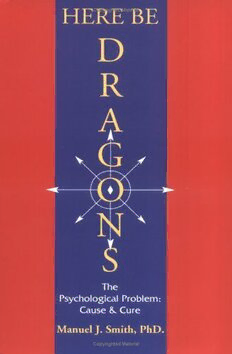
Here Be Dragons: The Psychological Problem, Cause & Cure PDF
200 Pages·2002·6.688 MB·English
Most books are stored in the elastic cloud where traffic is expensive. For this reason, we have a limit on daily download.
Preview Here Be Dragons: The Psychological Problem, Cause & Cure
Description:
If you liked When I Say No, I Feel Guilty, you will love Here Be Dragons, with the skills in "Guilty" applied to all sorts of problems each of us face in life. Dr. Smith's first book, When I Say No, I Feel Guilty, is an acclaimed national and world bestseller with over five million copies printed in fifteen languages. In creating techniques used in "Guilty" to teach people to assertively respond to threatening critique of their wants by others who emotionally manipulate them, Dr. Smith developed the best known, simple and systematic methods for dealing behaviorally with abstract anxiety concerns, such as guilt, self-worth and self-respect, which also form the fundamental emotional crux of the problems people bring into traditional talk psychotherapy. This is analogous to finding out that aspirin. developed to ease toothaches, can also be used to treat coronary disease. From his years of experience observing and evaluating patients in the field, having problems ranging from the mildest to the most severe and violent disorders, then involuntarily hospitalizing people when necessary, as well as treating psychological problems in the psychotherapy office suite, Dr. Smith clarifies and simplifies the traditional viewpoint by which psychological difficulties people undergo are looked at. Besides the physical, organic, and psychotic disorders, which are rarely seen in the practice of traditional talk psychotherapy, the vast majority of problems people bring into the psychotherapy office can be seen and succesfully treated as an unresolved abstract anxiety-phobic response in disguise involving self-worth, self-respect and guilt. They are basically unresolved emotional psychological problems associated with significant changes in five psychological stages of life; parent-child maturation, school-career, courting-relationship, sociosexual-marriage, aging-loss. Within this framework, Dr. Smith defines the five steps in the development of the psychological problem for use in both understanding the etiology of the problem as well as its diagnosis. Then he uses the analogy of the Here Be Dragons coping model - the Medieval warning of an unknown but perceived anxiety threat - as a simple learning device to understand and recognize the basic automatic, primitive, and childish coping reactions inherited from our animal ancestors, i.e., "Remove The Dragon" or "Remove Yourself From The Dragon" which can turn a fixable problem of living into a chronic psychological one. This maladaptive coping is compared to the more psychologically adult coping responses of "Defang The Dragon" and "Learning To Live With Dragons," or being able to cope with all the negatives and unknown anxieties life inflicts upon us. Either in the self-help mode or in traditional talk psychotherapy, the methods in Here Be Dragons The Psychological Problem, Cause And Cure are designed to help the person with the problem resolve it, as well as prevent others from occurring through poor coping with life's presentations to us of an inexorable series of "Dragons" threatening our self-worth and self-respect.
See more
The list of books you might like
Most books are stored in the elastic cloud where traffic is expensive. For this reason, we have a limit on daily download.
